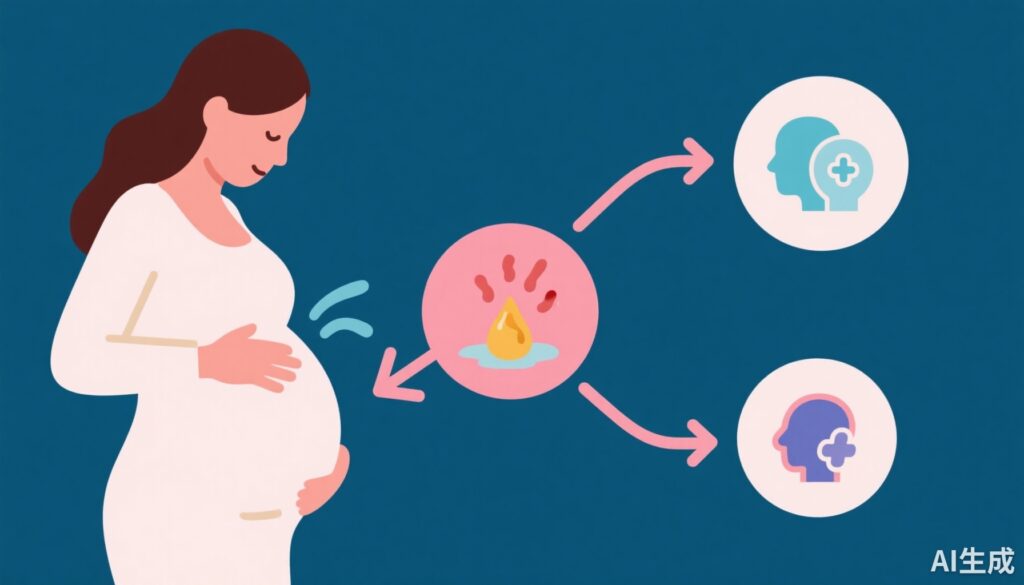Introduction
Hyperemesis gravidarum (HG) is an extreme form of nausea and vomiting during pregnancy, affecting a significant subset of pregnant women globally. Although its physical symptoms are well-recognized, the psychiatric comorbidities, particularly depression, have generated ongoing scientific debate due to inconsistent findings in previous studies. Addressing this gap, the recent Finnish nationwide register-based controlled study provides valuable insights into the bidirectional association between HG and depression, emphasizing the importance of a holistic approach to maternal health.
Background and Clinical Context
Hyperemesis gravidarum is characterized by persistent vomiting leading to dehydration, weight loss, and electrolyte imbalances. It often necessitates hospitalization and can profoundly impact a woman’s physical health and quality of life during pregnancy. Beyond its immediate physical burden, emerging evidence suggests that women experiencing HG may also face elevated risks of psychiatric disorders, especially depression, both pre-pregnancy and postpartum. Conversely, women with a history of depression may be more susceptible to developing severe nausea and vomiting during pregnancy, indicating a complex, potentially bidirectional relationship.
Despite these indications, prior research has produced mixed results, partly due to methodological differences and limited population-based data. Clarifying this relationship has crucial implications for clinical practice, emphasizing the need for integrated screening and management strategies that encompass mental health in obstetric care.
Study Design and Methods
The Finnish study utilized a robust national registry approach, encompassing data from 2004 to 2017. It included all women with at least one livebirth pregnancy within this period, excluding abortions, ectopic pregnancies, and stillbirths for clarity. Women with hyperemesis gravidarum during their first pregnancy leading to delivery from January 1, 2005, to December 31, 2017, were classified as cases, while those without HG constituted controls.
Data on hyperemesis gravidarum and psychiatric diagnoses, including depression, were collected from the Finnish Hospital Discharge Register. Pre-pregnancy depression was assessed at least one year before pregnancy, and new-onset depression was identified after delivery, with follow-up extending up to December 31, 2017. The primary outcomes focused on diagnoses of depression, categorized under ICD-10 codes F32, F33, and F34.1.
The analysis employed binary logistic regression models adjusted for potential confounders such as age, body mass index (BMI), socioeconomic status, smoking status, and psychiatric comorbidities other than depression. Notably, individuals involved in the study design had lived experience of mental health issues, providing an inclusive perspective.
Major Findings and Results
The study analyzed data from 437,465 women with pregnancy outcomes during the study period, with 4,265 women diagnosed with hyperemesis gravidarum in their first pregnancy resulting in delivery. The findings were striking:
– Women with HG were significantly more likely to have had a pre-pregnancy depression diagnosis. Specifically, 8.8% of the HG group versus 1.0% of the control group had pre-existing depression (adjusted OR 5.2, 95% CI 4.3-6.3, p<0.0001).
– Postpartum depression diagnoses also demonstrated a substantial association. Among women with HG, 4.9% developed depression after delivery compared to 1.0% in controls, with an adjusted OR of 3.6 (95% CI 3.0-4.4, p<0.0001).
– The majority of depression diagnoses occurred more than one year after delivery, emphasizing a long-term mental health burden. However, women with HG were diagnosed earlier postpartum (median 3.3 years) than controls (median 4.5 years, p<0.0002).
These results underscore a strong bidirectional relationship: pre-existing depression increases the risk of HG during pregnancy, and experiencing HG elevates the risk of developing depression after childbirth.
Clinical and Biological Implications
The bidirectional association observed supports the hypothesis of shared biological mechanisms, potentially involving hormonal pathways (such as human chorionic gonadotropin and estrogen) or immune-inflammatory processes that influence both nausea/vomiting and mood regulation. It also raises the possibility that severe nausea might trigger or exacerbate mental health symptoms, while pre-existing depression may influence hormonal responses that predispose women to HG.
Recognizing this interconnectedness highlights the importance of routine psychiatric screening in pregnant women, particularly those with severe nausea, and the need to monitor mental health longitudinally. The findings advocate for an integrated care model involving obstetricians, psychiatrists, and primary care providers.
Limitations and Future Directions
While the study’s nationwide scope and comprehensive data collection strengthen its conclusions, some limitations warrant mention. The lack of ethnicity data limits assessment of cultural or genetic factors. Additionally, registry-based diagnoses may underestimate actual prevalence due to underreporting or undiagnosed cases. Further research should explore mechanistic pathways, and interventional studies are needed to evaluate whether targeted mental health interventions can mitigate HG severity or improve postpartum outcomes.
Conclusion and Clinical Recommendations
This pivotal Finnish study reveals a significant, bidirectional association between hyperemesis gravidarum and depression, emphasizing the intertwined nature of physical and mental health in pregnancy. For clinicians, these findings advocate for systematic screening for depression during and after pregnancy, especially in women with severe nausea and vomiting. Early identification and treatment of depression could improve maternal well-being and pregnancy outcomes.
Integrated clinical pathways involving mental health assessment, hormonal evaluations, and personalized support are crucial. Strengthening interdisciplinary collaboration will be key in translating these insights into improved maternal health strategies and reducing long-term psychiatric morbidity in this vulnerable population.


